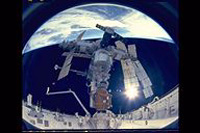Click on image for full size
NASA
The Space Station Saga Continues (Updated!)
News story originally written on July 22, 1997
The two cosmonauts aboard space station Mir were scheduled to perform a necessary spacewalk on July 18th in order to fix the damages caused by the June 25th collision. More troubles have struck the station though. Russian flight commander Vasily Tsibliev told flight surgeons he was experiencing heart problems. Tsibliev complained about heartbeat irregularities, but has felt no distinct pain. Tsibliev, age 43, has had no previous health problems. In fact, he blames the problem on stress caused by the earlier collision. Russian officials said that Tsibliev's condition does not appear to be serious. In fact, the heart beat irregularities may be due to the long-duration stay in a microgravity environment. Muscles (including the heart) have been known to weaken in microgravity environments because those environments simply don't require intensive usage of muscles. Tsibliev and flight engineer Lazutkin will return August 14th after their 7 month stay on Mir.
New recovery plans include a spacewalk inside the damaged laboratory on August 20th and outside Mir on September 3rd. The spacewalk will be handled by cosmonauts Anatoly Solovyov and Pavel Vinogradov, who will arrive at Mir August 7th. French astronaut Leopold Eyharts who was scheduled to fly with that crew, will remain on Earth because Mir does not have enough power to run his experiments.
U.S. astronaut Foale will remain on Mir until his replacement Wendy Lawrence arrives mid-September aboard shuttle Atlantis.















